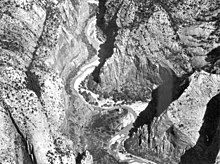Entrenched river

An entrenched river, or entrenched stream is a river or stream that flows in a narrow trench or valley cut into a plain or relatively level upland. Because of lateral erosion streams flowing over gentle slopes over a time develops meandering (snake like pattern) course. Meanders form where gradient is very gentle, for example in floodplain and delta. Meandering is the feature of the middle and final course of the river. But very deep and wide meanders can also be found cutting hard rocks. Such meanders are called incised or entrenched meanders. The exception is that entrenched meanders are formed during the upliftment of land where river is young. They widen and deepen over time and can be found as deep gorges or canyons in hard rock.[1][2] In the case of an entrenched stream or river, it is often presumed that the watercourse has inherited its course by cutting down into bedrock from a pre-existing plain with little modification of the original course. The down-cutting of the river system could be the result not only of tectonic uplift but also of other factors such as river piracy, decrease of load, increase of runoff, extension of the drainage basin, or change in base level such as a fall in sea level.[1][3][4] General, nongeneric terminology for either a river or stream that flows in a narrow trench or valley, for which evidence of a preexisting plain or relatively level upland can be either absent or present is either valley meander or meander valley with the latter term being preferred in literature.[5]
The
Causes
As observed above, an entrenched river can be caused by either tectonic uplift in the area or when the lowering of the sea level occurs. It can also be caused by increased level of downcutting or a collapse of moraine-dammed lake downstream, or capture of the river by another river. Moreover, the process of river rejuvenation can also be the cause of river entrenchment, especially when the process has occurred due to tectonic uplift. River rejuvenation increases the power of the flowing water and, therefore, the process of erosion is accelerated.
Studies show that
Several studies have cited
Consequences
Rosgen indicates that the consequences of incised
River restoration
River entrenchment causes negative impacts, such as accelerated stream bank erosion, land loss, loss of aquatic habitat, loss of land productivity, lowering of water table and sedimentation of the river downstream. However, in order to offset these problems, channel restoration measures focusing on restoration of the river in its original or to its previous characteristics are available. Though to achieve good results, a good understanding of the river patterns and profile of stable channels is a critical requirement. The process also needs an elaborate procedure to be followed to ensure all important factors and actions are followed. Numerous projects across the globe involving river restoration have been conducted, and a good example of such projects is Maggie Creek, Nevada. The project was completed in 1990 on upper Maggie Creek in Nevada. It was a partnership between the government and a private ranch, and the project entailed straightening of many miles of unstable gravel bed regarded as the C4/D4 type.
See also
- River rejuvenation
- River Terrace
- Water Table
References
- ^ ISBN 0-922152-76-4
- ISBN 0-07-143397-X
- ^ ISBN 0-922152-76-4
- ISBN 978-0-415568-01-2
- ^ ISBN 978-3-642-83779-1
- ^ Shields Jr, F. Douglas, Andrew Simon, and Lyle J. Steffen. "Reservoir effects on downstream river channel migration." Environmental Conservation 27.01 (2000): 54-66.
- ^ Goldberg, Paul, Vance Holliday T., and Reid Ferring C. Earth Sciences and Archaeology. Boston, MA: Springer US, 2001. Print.
- ^ Posamentier, Henry W. "Lowstand alluvial bypass systems: incised vs. unincised." AAPG bulletin 85.10 (2001): 1771-1793.
- ^ Hereford, Richard. Entrenchment and Widening of the Upper San Pedro River, Arizona. Boulder, Colo, 2003. Print.
- ISBN 0-937099-05-8, 1997.
- ^ Simon, Andrew, and Andrew JC Collison. "Quantifying the mechanical and hydrologic effects of riparian vegetation on streambank stability." Earth Surface Processes and Landforms 27.5 (2002): 527-546.
- ^ Pizzuto, Jim. "Effects of Dam Removal on River Form and Process Although many well-established concepts of fluvial geomorphology are relevant for evaluating the effects of dam removal, geomorphologists remain unable to forecast stream channel changes caused by the removal of specific dams." BioScience 52.8 (2002): 683-691.
